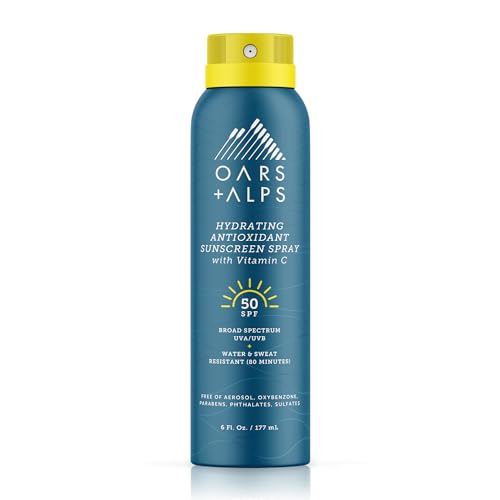
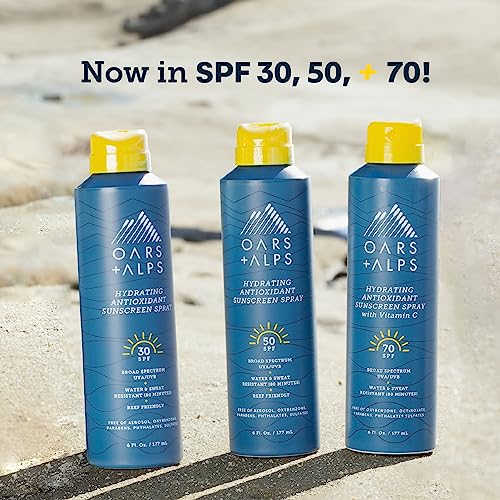
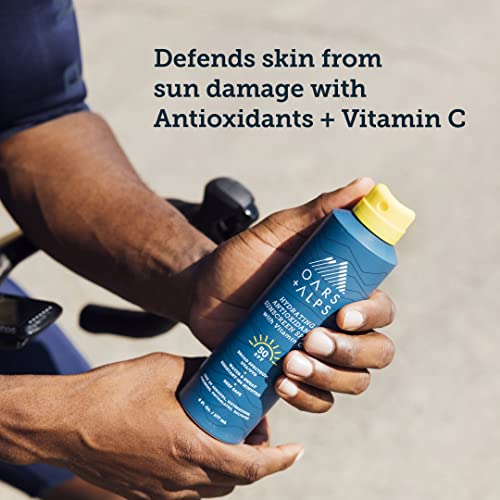
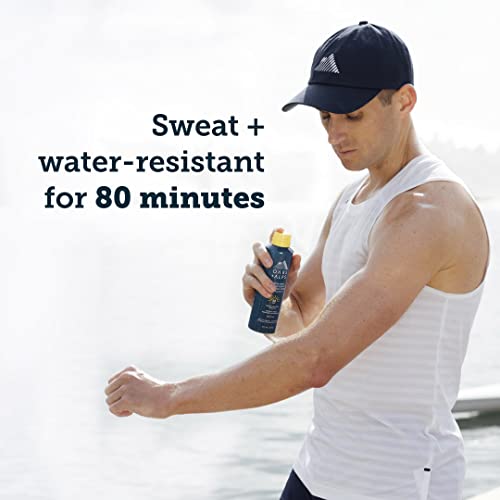
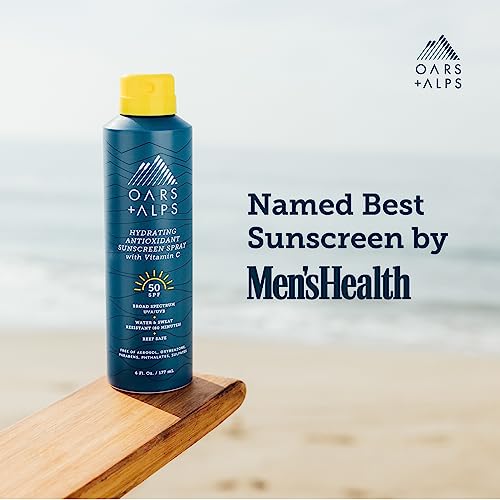
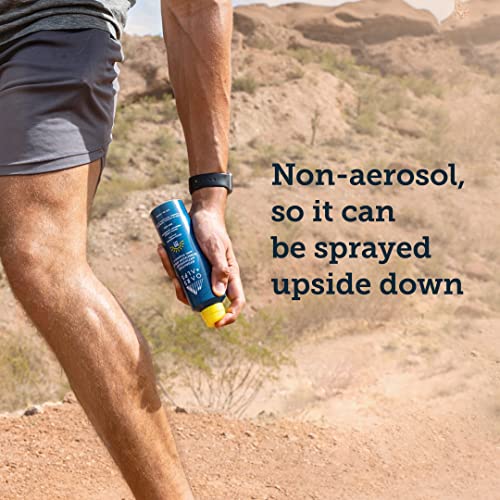
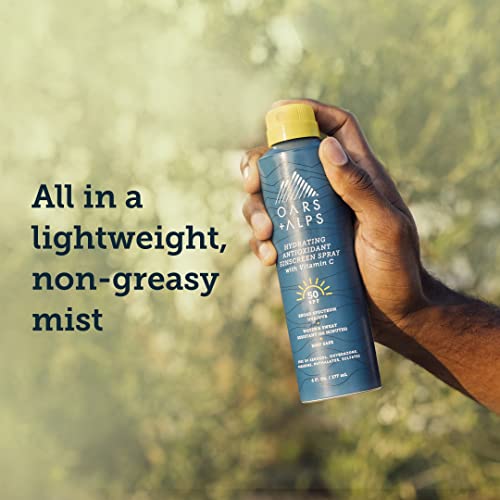
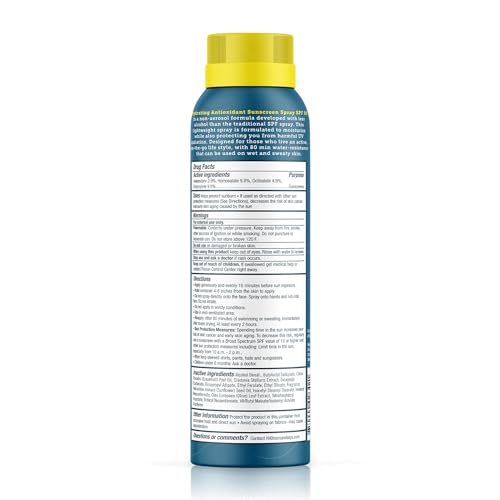
Oars + Alps Hydrating SPF 50 Sunscreen Spray - Nourishing Vitamin C, Water-Resistant - 6 Oz


Fragrance
High RiskFragrance refers to a mixture of aromatic compounds used in products to provide scent. It is commonly listed as 'fragrance' or 'parfum' on product labels and can serve various functions, including enhancing user experience and masking undesirable odors.
Sustai Insights
Fragrance offers functional benefits by improving product appeal; however, it poses significant health risks, notably a high likelihood of causing allergies and allergic contact dermatitis. Environmental risks include potential pollution and endocrine disruption, though its overall carcinogenicity is low. Regulatory bodies have noted concerns regarding its use, leading to a high-risk classification. Safe usage practices should be observed, and alternatives such as natural essential oils are recommended for those sensitive to synthetic fragrances.
Butyloctyl Salicylate
Medium RiskButyloctyl salicylate is a synthetic compound often used in cosmetic formulations for its ability to enhance skin absorption and stability of products. It primarily functions as a UV filter, providing protection against harmful sun rays in various personal care items.
Sustai Insights
Butyloctyl salicylate offers functional benefits as a UV filter and enhances skin absorption in formulations. However, it is associated with moderate usage restrictions due to potential health risks such as skin irritation and concerns regarding enhanced absorption. Environmental considerations include its pollutant potential, though it is not highly bioaccumulative. Regulatory bodies have placed limitations on its use in certain products, reflecting a medium risk assessment overall. Safe usage practices are advisable, and alternatives like natural UV filters may be considered.
Citrus Paradisi (Grapefruit) Oil
Medium RiskCitrus paradisi (grapefruit) oil is an essential oil derived from the peel of grapefruit. It is commonly used in personal care products for its fragrance and potential antibacterial properties. It is also utilized in aromatherapy and cosmetic formulations for its refreshing scent.
Sustai Insights
Citrus paradisi oil offers functional benefits such as fragrance enhancement and potential antimicrobial properties. However, it presents a high allergenic potential, which may cause skin irritation or allergic reactions in sensitive individuals. Environmental concerns include its persistence and bioaccumulation. Regulatory advisories exist that restrict its use in certain products, leading to an overall moderate risk assessment. Safe usage practices should be followed to minimize health risks, and alternatives such as essential oils with lower allergenic profiles could be considered.
Avobenzone
Medium RiskAvobenzone is an organic compound commonly used in sunscreens and skincare products for its ability to absorb ultraviolet (UV) radiation. It provides broad-spectrum protection against UVA rays, helping to prevent skin damage caused by sun exposure. However, it is known to degrade when exposed to sunlight unless stabilized with other ingredients.
Sustai Insights
Avobenzone effectively protects against UVA rays, making it a valuable ingredient in sun care products. However, it has moderate use restrictions due to its instability in sunlight, which can lead to enhanced skin absorption and potential irritation. Regulatory bodies restrict its use in certain formulations, categorizing it as having low concerns for cancer, allergies, and reproductive toxicity. Environmental risks include its potential as a pollutant, though it is not highly bioaccumulative. Overall, the ingredient poses medium risk, and users should adhere to product recommendations for safe application.
Octisalate
Medium RiskOctisalate is a weak UVB absorber commonly used in sunscreen formulations to enhance sun protection. It functions by absorbing ultraviolet radiation, thereby preventing sunburn and skin damage. This ingredient is often combined with other UV filters to achieve a broad-spectrum protective effect.
Sustai Insights
Octisalate provides effective UVB protection in sun care products, contributing to skin safety by reducing sunburn risk. Its environmental impact is moderate, with some concerns about its potential as an endocrine disruptor and possible restrictions in specific regions. Health risks are generally low, with low to moderate concerns regarding allergies and immunotoxicity. Regulatory bodies have verified its safe use under certain conditions, leading to an overall moderate risk assessment. For safer alternatives, consider mineral-based UV filters or other approved organic compounds.
Homosalate
Medium RiskHomosalate is a synthetic sunscreen ingredient primarily used in cosmetic formulations to absorb UV radiation, providing protection against sun exposure. It is commonly included in sunscreen products and is known for its effectiveness in enhancing the SPF of formulations.
Sustai Insights
Homosalate functions effectively as a UV filter, contributing to sun protection in cosmetic products. However, it is associated with moderate regulatory restrictions and concerns regarding its potential as an endocrine disruptor, though cancer and allergy risks are considered low. Environmental implications include its status as a pollutant, with some risk of bioaccumulation. Regulatory bodies have issued advisories that warrant caution in usage, leading to an overall moderate risk assessment. Safer alternatives may be available for consumers seeking to minimize exposure to this ingredient.
Ethyl Olivate
Low RiskEthyl olivate is an ethyl ester of the fatty acid derived from olive oil, commonly used as an emollient and skin-conditioning agent in cosmetic formulations. It helps to improve the texture and spreadability of products, providing moisture and enhancing skin feel.
Sustai Insights
Ethyl olivate is valued for its emollient properties, effectively moisturizing and improving product texture. It is considered biodegradable, aligning with sustainability goals. Health risks are minimal, with low concerns regarding carcinogenicity, allergies, and reproductive toxicity. Environmental risks are also low, and it is not subject to any regulatory restrictions. Overall, it is assessed to present a low risk, making it a safe choice in formulations. Alternatives may include other plant-derived esters, depending on formulation needs.
Dicapryl Carbonate
Low RiskDicapryl carbonate is an ester derived from caprylic acid and carbonic acid. It is used primarily as an emollient and skin conditioning agent in cosmetic formulations, providing a smooth and soft feel to the skin.
Sustai Insights
Dicapryl carbonate serves as an effective emollient, enhancing the texture of skincare products. It is biodegradable and sustainably sourced, contributing positively to environmental sustainability. Health risks are minimal, with low concerns for cancer, allergies, or reproductive toxicity. There are no significant environmental hazards associated with its use, and it is not subject to regulatory restrictions. Overall, the ingredient presents a low risk profile, making it a favorable choice in cosmetic applications.
Alcohol Denatured
Low RiskAlcohol denatured, also known as specially denatured (SD) alcohol, is a mixture of ethanol and other substances that render it unsuitable for consumption. It is commonly used in cosmetic and personal care products as a solvent, preservative, and penetration enhancer, facilitating the absorption of other ingredients.
Sustai Insights
Alcohol denatured offers functional benefits as a solvent and preservative, aiding in the formulation of various products. It is not associated with significant health risks, with low concerns regarding carcinogenicity, allergies, and reproductive toxicity. Environmental risks are minimal, and it is not classified as a pollutant. Regulatory bodies do not impose major restrictions on its use, indicating a low overall risk level. Safe usage practices should be followed to minimize exposure, and alternative solvents can be considered for those seeking greener options.
Va/Butyl Maleate/Isobornyl Acrylate Copolymer
Low RiskVA/Butyl Maleate/Isobornyl Acrylate Copolymer is a synthetic polymer used primarily as a film-forming agent in personal care and cosmetic products. It aids in enhancing texture and improving product stability by providing a smooth application and long-lasting effects.
Sustai Insights
This copolymer serves as an effective film former, contributing to product stability and smooth application. It has low health risk concerns, with negligible evidence of carcinogenicity, allergenic potential, or reproductive toxicity. Environmentally, it poses low risks regarding pollution and bioaccumulation. Regulatory assessments indicate no significant restrictions, underscoring its safety profile. Overall, it is considered low risk, making it a suitable choice in formulations, though alternatives may be explored for those seeking more natural ingredients.
Olea Europaea (Olive) Leaf Extract
Low RiskOlea europaea (olive) leaf extract is an extract derived from the leaves of the olive tree, primarily known for its antioxidant properties. It is used in various cosmetic and personal care products for its potential skin benefits, including moisturizing and soothing effects.
Sustai Insights
Olea europaea (olive) leaf extract offers functional benefits such as antioxidant properties and skin-soothing effects, making it valuable in skincare formulations. It is generally recognized as safe with low concerns regarding carcinogenicity, allergies, and reproductive toxicity. Environmental risks are minimal, and it is not associated with significant pollution or bioaccumulation. Regulatory bodies have not issued warnings, supporting its low-risk classification. Safe usage practices include limiting concentration levels to enhance efficacy while minimizing irritation. Alternatives to consider may include other plant extracts with similar benefits, but overall, the ingredient is assessed to be low risk.
Isodecyl Neopentanoate
Low RiskIsodecyl neopentanoate is the ester of branched-chain alcohol (isodecanol) and neopentanoic acid. It is primarily used as an emollient and skin-conditioning agent in cosmetic formulations, providing a smooth application and enhancing product texture.
Sustai Insights
Isodecyl neopentanoate offers functional benefits as a skin-conditioning agent, enhancing product texture and feel. It is not associated with significant health risks, with low concerns regarding carcinogenicity, allergies, and reproductive toxicity. Environmentally, it presents low pollution and bioaccumulation risks. Regulatory bodies do not impose major restrictions on its use, indicating overall low risk. Safe usage practices should be followed, and alternatives are available for those seeking different formulations.
Diisopropyl Adipate
Low RiskDiisopropyl adipate is a diester derived from isopropyl alcohol and adipic acid. It serves primarily as an emollient and skin-conditioning agent in cosmetic formulations, enhancing texture and providing a smooth feel to products.
Sustai Insights
Diisopropyl adipate offers functional benefits as a lightweight emollient that improves product spreadability and moisture retention. It has low associated health risks, with minimal concerns regarding carcinogenicity, allergies, or reproductive toxicity. Environmentally, it poses low risks, lacking significant pollutant potential or bioaccumulation. Regulatory assessments indicate no major restrictions. Overall, it is considered low risk, with recommended usage at safe levels, and alternatives may include other esters or plant-based oils for similar effects.
Isocetyl Stearoyl Stearate
Low RiskIsocetyl stearoyl stearate is an ester used primarily as an emulsifier and skin conditioning agent in cosmetic formulations. It aids in the stabilization and texture of products, contributing to a smooth application and enhancing moisture retention.
Sustai Insights
Isocetyl stearoyl stearate provides effective emulsification and skin conditioning, with low risks associated with cancer, allergies, and developmental toxicity. It is not on any regulatory restriction lists, indicating a favorable safety profile. Although there are minimal environmental concerns, including potential irritation, overall, the ingredient is assessed as low risk. Safe usage practices should be adhered to, and while alternatives exist, they may not perform identically.
Helianthus Annuus (Sunflower) Seed
Low RiskHelianthus annuus (sunflower) seed is derived from the seeds of the sunflower plant and is commonly used in various cosmetic and personal care products. It serves primarily as an emollient and skin conditioning agent, providing moisture and enhancing the texture of formulations.
Sustai Insights
Helianthus annuus (sunflower) seed offers functional benefits, including skin conditioning and moisturizing properties, while being sustainably sourced and biodegradable. Health risks are minimal, with low concerns for carcinogenicity, allergies, and reproductive toxicity. Environmentally, it presents low risks of pollution or bioaccumulation. Regulatory assessments indicate no current restrictions. Overall, it is considered a low-risk ingredient, and safe usage practices should be maintained. Alternative ingredients may include other plant-based oils, but the sunflower seed oil remains a viable option.
Tridecyl Neopentanoate
Low RiskTridecyl neopentanoate is an ester derived from tridecyl alcohol and neopentanoic acid, commonly used in cosmetic formulations as an emollient and skin-conditioning agent. It provides a silky, smooth feel and helps to enhance the texture of products.
Sustai Insights
Tridecyl neopentanoate offers functional benefits as an emollient, improving product texture and skin feel. It is considered low risk for health concerns, including carcinogenicity, allergies, and irritation. Environmental risks are minimal, and it is not currently restricted by regulatory bodies. Usage recommendations include standard cosmetic concentrations, and there are sustainable alternatives like plant-derived esters available. Overall, this ingredient presents a low risk profile.
Ethyl Ferulate
Low RiskEthyl ferulate is an ester of ferulic acid, primarily used for its antioxidant properties in cosmetic and skincare formulations. It is known for its ability to stabilize and enhance product efficacy, often serving as a preservative and UV protectant in various applications.
Sustai Insights
Ethyl ferulate offers functional benefits as an effective antioxidant and preservative, enhancing product stability. It is considered low risk regarding health concerns, with minimal associations to carcinogenicity, allergies, or reproductive toxicity. Environmentally, it poses low pollutant potential and is not bioaccumulative. Regulatory bodies do not impose restrictions on its use. Safe usage practices should be adhered to, while alternatives, such as natural antioxidants, could be considered for sustainability. Overall, ethyl ferulate is assessed to have low risk.
Diethylhexyl 2,6 Naphthalate
Low RiskDiethylhexyl 2,6 naphthalate is a phthalate compound primarily used as a plasticizer in various products, enhancing flexibility and durability. It is commonly found in materials such as plastics, adhesives, and coatings, contributing to product performance.
Sustai Insights
Diethylhexyl 2,6 naphthalate serves as an effective plasticizer, improving the workability and longevity of materials. While it has low concerns regarding cancer, allergies, and reproductive toxicity, there are moderate risks related to cumulative exposure from multiple sources. Environmentally, it is not classified as bioaccumulative or a significant pollutant. Regulatory bodies currently do not impose restrictions on its use. Overall, the risk level is considered low, and safer alternatives may include other biodegradable plasticizers.
Butyloctyl Salicylate
Medium RiskButyloctyl salicylate is a synthetic compound often used in cosmetic formulations for its ability to enhance skin absorption and stability of products. It primarily functions as a UV filter, providing protection against harmful sun rays in various personal care items.
Sustai Insights
Butyloctyl salicylate offers functional benefits as a UV filter and enhances skin absorption in formulations. However, it is associated with moderate usage restrictions due to potential health risks such as skin irritation and concerns regarding enhanced absorption. Environmental considerations include its pollutant potential, though it is not highly bioaccumulative. Regulatory bodies have placed limitations on its use in certain products, reflecting a medium risk assessment overall. Safe usage practices are advisable, and alternatives like natural UV filters may be considered.
Ethyl Olivate
Low RiskEthyl olivate is an ethyl ester of the fatty acid derived from olive oil, commonly used as an emollient and skin-conditioning agent in cosmetic formulations. It helps to improve the texture and spreadability of products, providing moisture and enhancing skin feel.
Sustai Insights
Ethyl olivate is valued for its emollient properties, effectively moisturizing and improving product texture. It is considered biodegradable, aligning with sustainability goals. Health risks are minimal, with low concerns regarding carcinogenicity, allergies, and reproductive toxicity. Environmental risks are also low, and it is not subject to any regulatory restrictions. Overall, it is assessed to present a low risk, making it a safe choice in formulations. Alternatives may include other plant-derived esters, depending on formulation needs.
Citrus Paradisi (Grapefruit) Oil
Medium RiskCitrus paradisi (grapefruit) oil is an essential oil derived from the peel of grapefruit. It is commonly used in personal care products for its fragrance and potential antibacterial properties. It is also utilized in aromatherapy and cosmetic formulations for its refreshing scent.
Sustai Insights
Citrus paradisi oil offers functional benefits such as fragrance enhancement and potential antimicrobial properties. However, it presents a high allergenic potential, which may cause skin irritation or allergic reactions in sensitive individuals. Environmental concerns include its persistence and bioaccumulation. Regulatory advisories exist that restrict its use in certain products, leading to an overall moderate risk assessment. Safe usage practices should be followed to minimize health risks, and alternatives such as essential oils with lower allergenic profiles could be considered.
Dicapryl Carbonate
Low RiskDicapryl carbonate is an ester derived from caprylic acid and carbonic acid. It is used primarily as an emollient and skin conditioning agent in cosmetic formulations, providing a smooth and soft feel to the skin.
Sustai Insights
Dicapryl carbonate serves as an effective emollient, enhancing the texture of skincare products. It is biodegradable and sustainably sourced, contributing positively to environmental sustainability. Health risks are minimal, with low concerns for cancer, allergies, or reproductive toxicity. There are no significant environmental hazards associated with its use, and it is not subject to regulatory restrictions. Overall, the ingredient presents a low risk profile, making it a favorable choice in cosmetic applications.
Alcohol Denatured
Low RiskAlcohol denatured, also known as specially denatured (SD) alcohol, is a mixture of ethanol and other substances that render it unsuitable for consumption. It is commonly used in cosmetic and personal care products as a solvent, preservative, and penetration enhancer, facilitating the absorption of other ingredients.
Sustai Insights
Alcohol denatured offers functional benefits as a solvent and preservative, aiding in the formulation of various products. It is not associated with significant health risks, with low concerns regarding carcinogenicity, allergies, and reproductive toxicity. Environmental risks are minimal, and it is not classified as a pollutant. Regulatory bodies do not impose major restrictions on its use, indicating a low overall risk level. Safe usage practices should be followed to minimize exposure, and alternative solvents can be considered for those seeking greener options.
Va/Butyl Maleate/Isobornyl Acrylate Copolymer
Low RiskVA/Butyl Maleate/Isobornyl Acrylate Copolymer is a synthetic polymer used primarily as a film-forming agent in personal care and cosmetic products. It aids in enhancing texture and improving product stability by providing a smooth application and long-lasting effects.
Sustai Insights
This copolymer serves as an effective film former, contributing to product stability and smooth application. It has low health risk concerns, with negligible evidence of carcinogenicity, allergenic potential, or reproductive toxicity. Environmentally, it poses low risks regarding pollution and bioaccumulation. Regulatory assessments indicate no significant restrictions, underscoring its safety profile. Overall, it is considered low risk, making it a suitable choice in formulations, though alternatives may be explored for those seeking more natural ingredients.
Avobenzone
Medium RiskAvobenzone is an organic compound commonly used in sunscreens and skincare products for its ability to absorb ultraviolet (UV) radiation. It provides broad-spectrum protection against UVA rays, helping to prevent skin damage caused by sun exposure. However, it is known to degrade when exposed to sunlight unless stabilized with other ingredients.
Sustai Insights
Avobenzone effectively protects against UVA rays, making it a valuable ingredient in sun care products. However, it has moderate use restrictions due to its instability in sunlight, which can lead to enhanced skin absorption and potential irritation. Regulatory bodies restrict its use in certain formulations, categorizing it as having low concerns for cancer, allergies, and reproductive toxicity. Environmental risks include its potential as a pollutant, though it is not highly bioaccumulative. Overall, the ingredient poses medium risk, and users should adhere to product recommendations for safe application.
Olea Europaea (Olive) Leaf Extract
Low RiskOlea europaea (olive) leaf extract is an extract derived from the leaves of the olive tree, primarily known for its antioxidant properties. It is used in various cosmetic and personal care products for its potential skin benefits, including moisturizing and soothing effects.
Sustai Insights
Olea europaea (olive) leaf extract offers functional benefits such as antioxidant properties and skin-soothing effects, making it valuable in skincare formulations. It is generally recognized as safe with low concerns regarding carcinogenicity, allergies, and reproductive toxicity. Environmental risks are minimal, and it is not associated with significant pollution or bioaccumulation. Regulatory bodies have not issued warnings, supporting its low-risk classification. Safe usage practices include limiting concentration levels to enhance efficacy while minimizing irritation. Alternatives to consider may include other plant extracts with similar benefits, but overall, the ingredient is assessed to be low risk.
Isodecyl Neopentanoate
Low RiskIsodecyl neopentanoate is the ester of branched-chain alcohol (isodecanol) and neopentanoic acid. It is primarily used as an emollient and skin-conditioning agent in cosmetic formulations, providing a smooth application and enhancing product texture.
Sustai Insights
Isodecyl neopentanoate offers functional benefits as a skin-conditioning agent, enhancing product texture and feel. It is not associated with significant health risks, with low concerns regarding carcinogenicity, allergies, and reproductive toxicity. Environmentally, it presents low pollution and bioaccumulation risks. Regulatory bodies do not impose major restrictions on its use, indicating overall low risk. Safe usage practices should be followed, and alternatives are available for those seeking different formulations.
Octisalate
Medium RiskOctisalate is a weak UVB absorber commonly used in sunscreen formulations to enhance sun protection. It functions by absorbing ultraviolet radiation, thereby preventing sunburn and skin damage. This ingredient is often combined with other UV filters to achieve a broad-spectrum protective effect.
Sustai Insights
Octisalate provides effective UVB protection in sun care products, contributing to skin safety by reducing sunburn risk. Its environmental impact is moderate, with some concerns about its potential as an endocrine disruptor and possible restrictions in specific regions. Health risks are generally low, with low to moderate concerns regarding allergies and immunotoxicity. Regulatory bodies have verified its safe use under certain conditions, leading to an overall moderate risk assessment. For safer alternatives, consider mineral-based UV filters or other approved organic compounds.
Diisopropyl Adipate
Low RiskDiisopropyl adipate is a diester derived from isopropyl alcohol and adipic acid. It serves primarily as an emollient and skin-conditioning agent in cosmetic formulations, enhancing texture and providing a smooth feel to products.
Sustai Insights
Diisopropyl adipate offers functional benefits as a lightweight emollient that improves product spreadability and moisture retention. It has low associated health risks, with minimal concerns regarding carcinogenicity, allergies, or reproductive toxicity. Environmentally, it poses low risks, lacking significant pollutant potential or bioaccumulation. Regulatory assessments indicate no major restrictions. Overall, it is considered low risk, with recommended usage at safe levels, and alternatives may include other esters or plant-based oils for similar effects.
Isocetyl Stearoyl Stearate
Low RiskIsocetyl stearoyl stearate is an ester used primarily as an emulsifier and skin conditioning agent in cosmetic formulations. It aids in the stabilization and texture of products, contributing to a smooth application and enhancing moisture retention.
Sustai Insights
Isocetyl stearoyl stearate provides effective emulsification and skin conditioning, with low risks associated with cancer, allergies, and developmental toxicity. It is not on any regulatory restriction lists, indicating a favorable safety profile. Although there are minimal environmental concerns, including potential irritation, overall, the ingredient is assessed as low risk. Safe usage practices should be adhered to, and while alternatives exist, they may not perform identically.
Helianthus Annuus (Sunflower) Seed
Low RiskHelianthus annuus (sunflower) seed is derived from the seeds of the sunflower plant and is commonly used in various cosmetic and personal care products. It serves primarily as an emollient and skin conditioning agent, providing moisture and enhancing the texture of formulations.
Sustai Insights
Helianthus annuus (sunflower) seed offers functional benefits, including skin conditioning and moisturizing properties, while being sustainably sourced and biodegradable. Health risks are minimal, with low concerns for carcinogenicity, allergies, and reproductive toxicity. Environmentally, it presents low risks of pollution or bioaccumulation. Regulatory assessments indicate no current restrictions. Overall, it is considered a low-risk ingredient, and safe usage practices should be maintained. Alternative ingredients may include other plant-based oils, but the sunflower seed oil remains a viable option.
Fragrance
High RiskFragrance refers to a mixture of aromatic compounds used in products to provide scent. It is commonly listed as 'fragrance' or 'parfum' on product labels and can serve various functions, including enhancing user experience and masking undesirable odors.
Sustai Insights
Fragrance offers functional benefits by improving product appeal; however, it poses significant health risks, notably a high likelihood of causing allergies and allergic contact dermatitis. Environmental risks include potential pollution and endocrine disruption, though its overall carcinogenicity is low. Regulatory bodies have noted concerns regarding its use, leading to a high-risk classification. Safe usage practices should be observed, and alternatives such as natural essential oils are recommended for those sensitive to synthetic fragrances.
Homosalate
Medium RiskHomosalate is a synthetic sunscreen ingredient primarily used in cosmetic formulations to absorb UV radiation, providing protection against sun exposure. It is commonly included in sunscreen products and is known for its effectiveness in enhancing the SPF of formulations.
Sustai Insights
Homosalate functions effectively as a UV filter, contributing to sun protection in cosmetic products. However, it is associated with moderate regulatory restrictions and concerns regarding its potential as an endocrine disruptor, though cancer and allergy risks are considered low. Environmental implications include its status as a pollutant, with some risk of bioaccumulation. Regulatory bodies have issued advisories that warrant caution in usage, leading to an overall moderate risk assessment. Safer alternatives may be available for consumers seeking to minimize exposure to this ingredient.
Tridecyl Neopentanoate
Low RiskTridecyl neopentanoate is an ester derived from tridecyl alcohol and neopentanoic acid, commonly used in cosmetic formulations as an emollient and skin-conditioning agent. It provides a silky, smooth feel and helps to enhance the texture of products.
Sustai Insights
Tridecyl neopentanoate offers functional benefits as an emollient, improving product texture and skin feel. It is considered low risk for health concerns, including carcinogenicity, allergies, and irritation. Environmental risks are minimal, and it is not currently restricted by regulatory bodies. Usage recommendations include standard cosmetic concentrations, and there are sustainable alternatives like plant-derived esters available. Overall, this ingredient presents a low risk profile.
Ethyl Ferulate
Low RiskEthyl ferulate is an ester of ferulic acid, primarily used for its antioxidant properties in cosmetic and skincare formulations. It is known for its ability to stabilize and enhance product efficacy, often serving as a preservative and UV protectant in various applications.
Sustai Insights
Ethyl ferulate offers functional benefits as an effective antioxidant and preservative, enhancing product stability. It is considered low risk regarding health concerns, with minimal associations to carcinogenicity, allergies, or reproductive toxicity. Environmentally, it poses low pollutant potential and is not bioaccumulative. Regulatory bodies do not impose restrictions on its use. Safe usage practices should be adhered to, while alternatives, such as natural antioxidants, could be considered for sustainability. Overall, ethyl ferulate is assessed to have low risk.
Diethylhexyl 2,6 Naphthalate
Low RiskDiethylhexyl 2,6 naphthalate is a phthalate compound primarily used as a plasticizer in various products, enhancing flexibility and durability. It is commonly found in materials such as plastics, adhesives, and coatings, contributing to product performance.
Sustai Insights
Diethylhexyl 2,6 naphthalate serves as an effective plasticizer, improving the workability and longevity of materials. While it has low concerns regarding cancer, allergies, and reproductive toxicity, there are moderate risks related to cumulative exposure from multiple sources. Environmentally, it is not classified as bioaccumulative or a significant pollutant. Regulatory bodies currently do not impose restrictions on its use. Overall, the risk level is considered low, and safer alternatives may include other biodegradable plasticizers.
Experience sun protection like never before with Oars + Alps Hydrating SPF 50 Sunscreen Spray. Infused with Vitamin C and antioxidants, this non-greasy formula not only shields your skin from harmful UV rays but also nourishes and hydrates it. Perfect for those who care about their health and the environment, this sunscreen is designed for active lifestyles, providing water and sweat resistance for up to 80 minutes.
- Hydrating and Protective: Nourishes skin with Vitamin C while offering strong UV protection, making your sun exposure safer and more comfortable.
- Water and Sweat Resistant: Enjoy outdoor activities worry-free, as this sunscreen maintains its effectiveness for 80 minutes against sweat and water.
- Gentle Formula: Free from harsh chemicals like Oxybenzone and Parabens, this sunscreen is vegan, cruelty-free, and reef-safe, aligning with eco-conscious values.
- Lightweight and Non-Greasy: Achieve hydration without the oily residue; includes Alpine Caribou Moss and Olive Leaf Extract for added skin benefits.
- Refreshing Scent: Lightly fragranced with Summer Splash notes of amber and coconut water, this sunscreen brings a pleasant aroma to your sun protection routine.
Subscribe & Save with Sustai
- Best Price Guarantee: Always enjoy the lowest prices on sustainable home essentials.
- No Surprises: We’ll notify you before shipping. No hidden fees, ever.
- You’re in Charge: Change, pause, or cancel your subscription anytime with ease.
- Eco-Friendly Deliveries: Our grouped shipments mean less packaging and lower emissions.
Join us on a sustainable journey. Special offers for a limited time! Prices and promotions may change.
Recommended Products
Experience sun protection like never before with Oars + Alps Hydrating SPF 50 Sunscreen Spray. Infused with Vitamin C and antioxidants, this non-greasy formula not only shields your skin from harmful UV rays but also nourishes and hydrates it. Perfect for those who care about their health and the environment, this sunscreen is designed for active lifestyles, providing water and sweat resistance for up to 80 minutes.
- Hydrating and Protective: Nourishes skin with Vitamin C while offering strong UV protection, making your sun exposure safer and more comfortable.
- Water and Sweat Resistant: Enjoy outdoor activities worry-free, as this sunscreen maintains its effectiveness for 80 minutes against sweat and water.
- Gentle Formula: Free from harsh chemicals like Oxybenzone and Parabens, this sunscreen is vegan, cruelty-free, and reef-safe, aligning with eco-conscious values.
- Lightweight and Non-Greasy: Achieve hydration without the oily residue; includes Alpine Caribou Moss and Olive Leaf Extract for added skin benefits.
- Refreshing Scent: Lightly fragranced with Summer Splash notes of amber and coconut water, this sunscreen brings a pleasant aroma to your sun protection routine.

You can have at most 2 Sustainable Steals products in your cart
Customer Reviews
Customers’ View
Customers express overall satisfaction with the Sunscreen Spray, particularly appreciating its effective protection and user-friendly application. Many users report that the non-greasy formula provides hydration without leaving an oily residue, making it comfortable for daily use. The pleasant Summer Splash fragrance is also frequently mentioned as a positive feature. However, some reviewers note issues with the spray canister, indicating it may stop working before the product is fully utilized. Importantly, the sunscreen is highlighted for being vegan, cruelty-free, and reef-safe, aligning well with the values of environmentally conscious consumers. Overall, this product is deemed reliable for sun protection while being mindful of skin health and environmental impact.
AI-generated from the text of customer reviewsThis product is rated 4.3 of 5.0 stars.
It has received 19 reviews.




